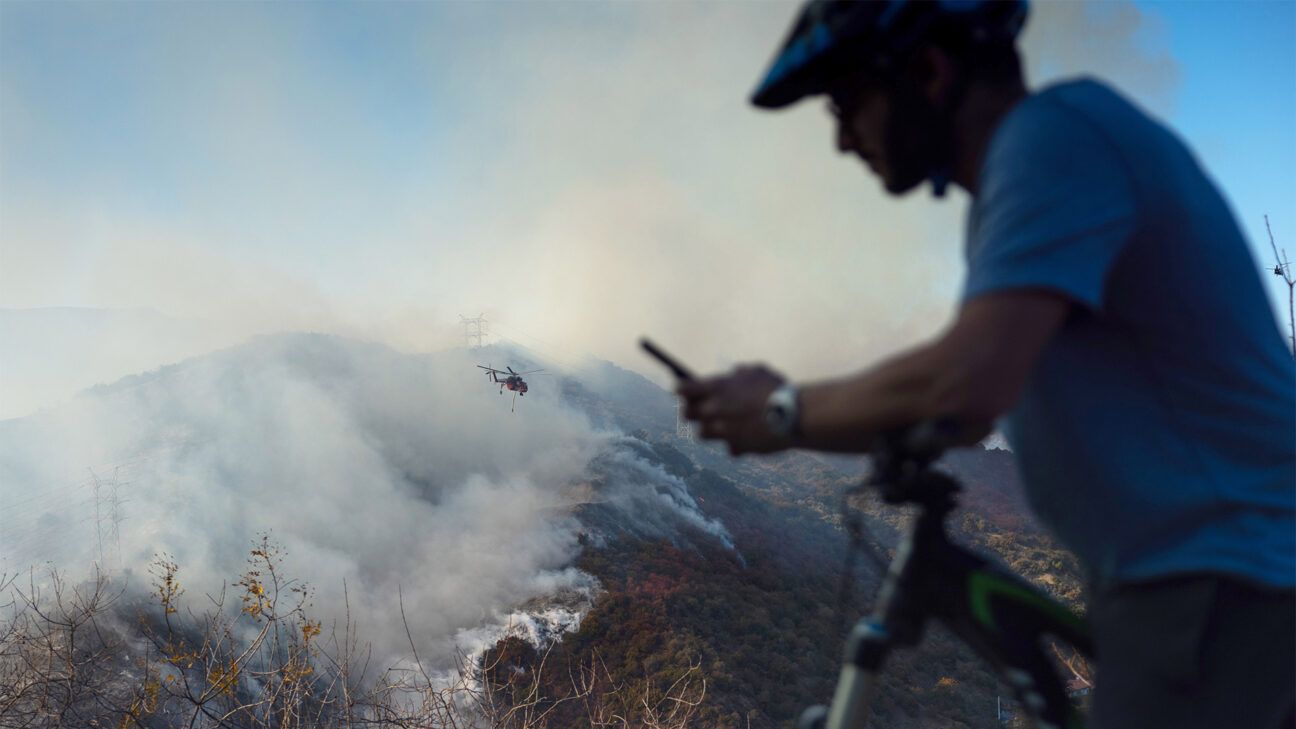
- Wildfire smoke exposure in the Greater Los Angeles area could raise the risk of respiratory problems, especially among sensitive groups.
- When wildfires ignite, they release tiny particulate matter called PM 2.5. These particles can hang in the air and, when inhaled, travel deep into the lungs.
- Before you exercise outdoors, it’s a good idea to check your local Air Quality Index (AQI) to stay safe.
A clear, blue sky is becoming a rarer sight for people living in the Greater Los Angeles area as smoky, hazy skies persist amid ongoing wildfires that have ravaged the surrounding region.
As of January 13, wildfires had burned nearly 40,000 acres and destroyed thousands of structures, with the death toll climbing to at least 24. More than 150,000 Los Angeles residents have been forced to evacuate their homes.
With dangerous Santa Ana winds expected to continue this week, the threat of more evacuations remains high as firefighters work to contain the blaze.
Many residents of the Los Angeles area are being exposed to harmful air quality as surrounding fires continue to burn.
When air quality is hazardous, you can minimize your exposure to pollutants by running an air purifier and keeping windows shut. If you need to be outside, you should consider the Air Quality Index (AQI), particularly if you want to exercise.
Check your local AQI levels to determine if going outside is safe. This measurement shows what the current nearby air quality is like.
However, reading and interpreting AQI is a bit of a guessing game. The AQI scale ranges from 0 to 500 and includes different tiers associated with various health risks for different groups of people.
Scientists are still uncovering all the short- and long-term health issues that come with inhaling wildfire smoke, but there’s enough evidence that shows a strong link between air pollution and respiratory and cardiovascular health problems.
Here’s what you need to know about wildfire smoke exposure while exercising outdoors.
When wildfires ignite, they release tiny particulate matter called PM 2.5.
These minuscule particles hang out in the air, and when inhaled, can get lodged deep inside the throat and lungs, according to Dr. Stephanie Christenson, an assistant professor in the division of pulmonary, critical care, allergy, and sleep medicine at University of California, San Francisco.
When that happens, the particles can cause a lot of adverse effects on our health.
In the short term, people who inhale air with high PM 2.5 levels may experience difficulty breathing, a cough, runny nose, eye irritation, sore throat, and heart palpitations.
People with underlying health issues — like asthma, chronic obstructive pulmonary disease (COPD), or heart disease — have a higher risk, as PM 2.5 can cause direct injury to the airways and lead to a lot of inflammation, exacerbating these conditions and sending some to the hospital.
Otherwise healthy people can feel the effects of the poor air quality, too.
“Even a normal person, if you have enough particulate matter in the air and are breathing enough in, you can get a lot of symptoms immediately or within hours to days,” Christenson said in an earlier interview.
AQI charts — which look at the amount of PM2.5 and other pollutants like ozone in the air — are typically displayed in different tiers:
- 0 to 50 – The air is good.
- 51 to 100 – The air is moderate, and people who are unusually sensitive may experience symptoms.
- 101 to 150 – The air is unhealthy for sensitive groups, like those with asthma or COPD.
- 151 to 200 – The air is unhealthy for people with conditions and sensitive groups; some people in the general public may also experience health effects.
- 201 to 300 – Health alert; risk factors are increased for everyone.
- 301 and up – The air is hazardous.
AQI charts can be confusing to navigate, since the tiers are wide and the particles can impact different people in different ways, according to Christine Wiedinmyer, PhD, the associate director for science at the Cooperative Institute for Research in Environmental Sciences at the University of Colorado Boulder.
Here’s how to determine whether it’s safe to exercise outdoors if you’re exposed to wildfire smoke.
The 0 to 50 range is the green zone
The air is relatively clean and this is the safest window for people with underlying conditions to go out and exercise.
The yellow zone ranges from 51 to 100
“With 50 to 100, we usually think it’s probably OK to open your windows and go outside and exercise, but some people may be particularly sensitive,” said Christenson in an earlier interview.
In the 100 to 150 range is the orange range
It gets a bit riskier, especially for people with underlying conditions.
“The common thought process is most people who are healthy are probably OK to go for a run,” Christenson said.
Some people, even those who are healthy, might feel some symptoms minutes, to hours, to days after exercising outside in the 100 to 150 range, but it’s really different from person to person.
This tier is a bit of a gray zone, according to Christenson, so you’ve really got to listen to your body.
If you start to feel anything — which is not always shortness of breath but sometimes headache, fatigue, dizziness, or palpitations — your body is telling you it needs clean air.
Above 150, the air is unhealthy for everyone
Quick activities such as going to the car to run an errand or taking the dog out should be OK, but you should really limit how much time you spend outdoors, said Christenson.
Spending more time outside, like an hour or two, or exercising outdoors, will probably be challenging and trigger some breathing issues.
“Try to limit exerting yourself too much,” Christenson said of the 100 to 150 range.
When the AQI spikes above 150, indicating the air is hazardous, everyone should avoid the outdoors and wear a N95 or P100 mask if you must go out.
Now, here comes the most important thing to understand about AQI charts: They’re based on the short-term health effects, not the long-term risks.
Scientists don’t have much data on the health issues caused by long-term exposure.
This makes it hard to gauge what’s truly safe to do outside at moderate and higher AQI levels, especially as wildfires last longer and ignite more frequently compared to past years.
“We don’t have good answers, like at what air quality index is it safe to go outside or do a hike or safe to exercise,” Wiedinmyer said.
While it might be OK to run outside when the air is moderate once or twice, doing so for days and weeks on end during wildfire season year after year could have major implications on your health down the road.
What kind of implications? Again, it’s unclear — but based on studies looking at air pollution in general, health experts assume long-term exposure to consistently high AQI levels may increase a person’s risk for developing asthma, COPD, heart disease, and some cancers.
It’s also thought that kids, whose immune systems aren’t fully developed, may experience diminished lung functioning later on in life, said Christenson.
Wiedinmyer has studied people who cook with open fires in developing countries and found that regular smoke exposure is linked to premature mortality and cardiovascular issues.
“The more you’re exposed, the worse things get,” Christenson said.
The number one thing to do is limit outside time when the AQI is high.
“If I can smell it, I stay inside. If the colors are orange, I stay inside,” Wiedinmyer said of her own strategy.
Pregnant people along with those who have asthma, respiratory problems, or heart conditions should take extra precautions.
Close and seal the windows and doors and bring your exercises inside.
Indoors, you’ll want to ensure the air quality is as good as possible, too, as air pollution can creep inside, especially in older rental units.
A portable air purifier with filters, which can be bought online or made at home, can help clear the air in your home.
Christenson also recommends cutting out other sources of pollution — candles, smoking, fires, even vacuuming, as it could kick up dust.
Lastly, keep in mind that the areas directly surrounding the wildfires aren’t the only areas experiencing poor air quality.
It’s not just a local issue, as polluted air has the potential to travel far, from state to state and across the country.
For people living near wildfires in the Los Angeles area, understanding the air quality index (AQI) charts can help you determine if you can safely workout, while outside.
The AQI scale ranges from 0 to 500 and includes different tiers associated with various health risks for different groups of people.
In general, the higher the AQI and the more you’re exposed to polluted air, the worse the potential health outcomes are.





